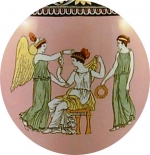To achieve proper printing results, choose 'Portrait Orientation' and 'Fit to Page' options in your print settings.
 |
|
Bates, Brown-Westhead, Moore & Co. (Maker) |
By 1856 John Ridgway had entered a completely different partnership in Staffordshire and his business is recorded in Kelly’s Directory as John Ridgway Bates & Co. At this time John Ridgway was over 70 years of age and may have been looking at succession planning for his successful pottery and porcelain manufactory. His partners William Bates (1825- and Thomas Chapell Brown-Westhead,(1837-83) had already been associated through a previous business when Bates father and older brothers and Brown-Westhead’s father were cotton wadding and woolen dealers in London, and were wadding and wool manufacturers in Surrey.[i] It is not clear how as young men became involved in the Staffordshire ceramic industry but, by 1856 Ridgway, Bates & Co. were established and listed in Kelly’s Directory published in September 1856. In July 1857 the company took 300 of the workforce to view the Art Treasures of Great Britain exhibition held at Old Trafford, Manchester[ii]. John Ridgway had always been a liberal employer; perhaps his new partners were also interested in the quality of life of their employees. In June of 1858 John Ridgway withdrew from the partnership leaving it in the capable hands of William Bates & Thomas Chappell Brown-Westhead. The business was centered at the Cauldon Works, Shelton in the Staffordshire Potteries, which became of the largest and most eminent factories in the district. In 1859 the Staffordshire Advertiser recorded that Mr. Bates was seriously injured by a horse at Cauldon Place Works, Shelton.[iii] Perhaps for this reason a new partner was enlisted and William Moore became part of the company. In December 1861 Bates withdrew from business and eventually moved away from the North Staffordshire Potteries. The company continued as T.C. Brown-Westhead, Moore & Co. For Bates Brown-Westhead, Moore & Co. ceramics on this site click here |
|
http://printedbritishpotteryandporcelain.com/who-made-it/bates-brown-westhead-moore-co-maker |
 The experienced potter John Ridgway was childless and coming to the end of his life when he entered into a short partnership which was officially titled John Ridgway, Bates & Co. Although a number of authorities have suggested that his partner was a nephew, Thomas Bates, there is no evidence to support this. John Ridgway’s nephew was Thomas Sanders Bale, and he was living with John and Sophia Ridgway (née Bale) at the time of the 1851 census. John Ridgway is listed as China Manufacturer and ‘Thomas Sanders Bale nephew’ aged 28 is listed as ‘One of the above firm’. John Ridgway did enter into a partnership, separately from his china and earthenware business, with his nephew and other members of his nephew’s family as manufacturers of architectural pottery, but left the concern in 1858.
The experienced potter John Ridgway was childless and coming to the end of his life when he entered into a short partnership which was officially titled John Ridgway, Bates & Co. Although a number of authorities have suggested that his partner was a nephew, Thomas Bates, there is no evidence to support this. John Ridgway’s nephew was Thomas Sanders Bale, and he was living with John and Sophia Ridgway (née Bale) at the time of the 1851 census. John Ridgway is listed as China Manufacturer and ‘Thomas Sanders Bale nephew’ aged 28 is listed as ‘One of the above firm’. John Ridgway did enter into a partnership, separately from his china and earthenware business, with his nephew and other members of his nephew’s family as manufacturers of architectural pottery, but left the concern in 1858. 